Here’s an exclusive list of Shrubs that Bloom All Year! Grow these Year-Round Shrubs according to seasons and fill your garden with colors!
Plant these Shrubs According to Different Seasons to Get Blooms All Year. These plants are low maintenance, flower beautifully, and look fantastic in pots too!
Have a look at some of the fastest-growing privacy shrubs here
Shrubs that Bloom All Year
Spring
1. Azalea
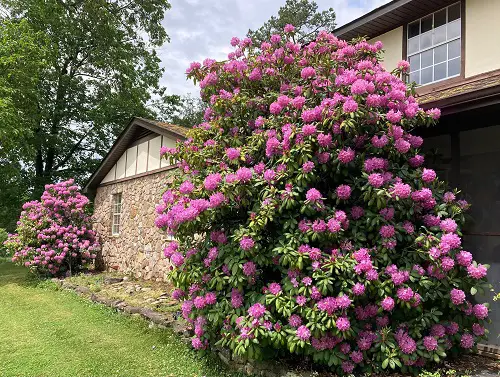
Botanical Name: Rhododendron spp
This excellent flowering shrub comes in many colors and sizes. It does best in moist soil with partial sunlight. Use a rich, acidic growing medium for the best results.
2. Bridal Wreath Spiraea
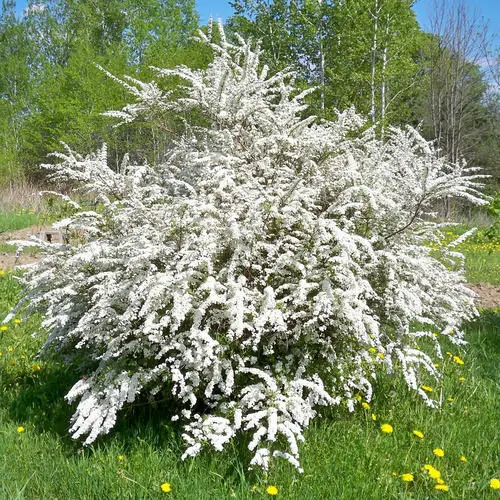
Botanical Name: Spiraea prunifolia ‘Plena’
This shrub showcases a tiny bunch of white flowers that bloom in the spring season. Grow it in bright sunlight and well-draining soil.
3. Brandywine

Botanical Name: Viburnum nudum
The white flowers of this shrub match beautifully with the dark green foliage. Also, be ready to see the plant covered in pink and blue berries in the fall!
4. Witch Hazel

Botanical Name: Hamamelis × intermedia ‘Arnold Promise’
If you like yellow flowers, then this shrub is for you. It does best in bright sun with a well-draining acidic growing medium.
5. Lantana

Botanical Name: Lantana camara
Lantanas feature round clustered blooms showing off myriad shades of white, red, orange, pink, yellow, blue, and purple. Provide the plant with 5-6 hours of direct sunlight.
Get the best care tips for Lantanas here
6. California Lilac

Botanical Name: Ceanothus
It is primarily grown for blue blossoms but often planted for pink or white blooms, which flower abundantly across a long period from spring.
Want to prepare your garden for spring? Click here
Summer
7. Hibiscus
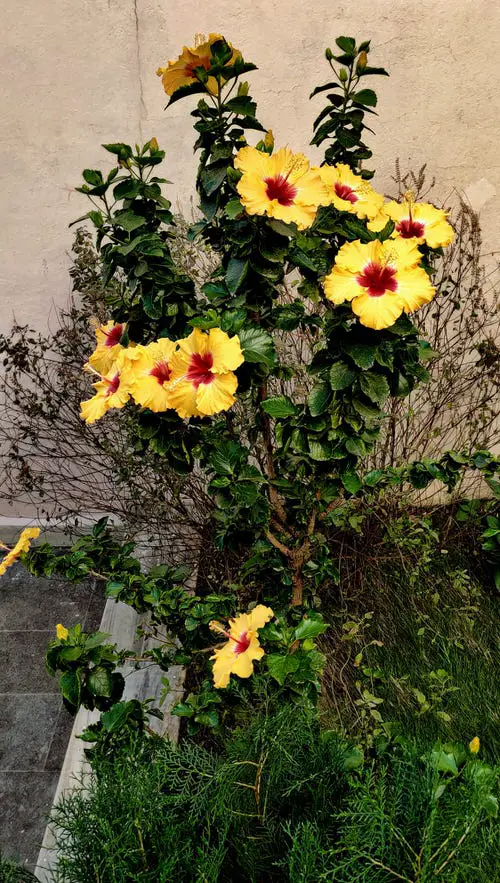
Botanical Name: Hibiscus
This shrub can grow to an impressive height of 3-6 feet. It develops clusters of blossoms in groups that look wonderful with its dark green foliage.
8. Butterfly Bush

Botanical Name: Buddleja
The shrub grows flowers in white, purple, yellow, and blue shades from summer until the first frost. It can easily survive drought and summer heat.
9. Mock Orange
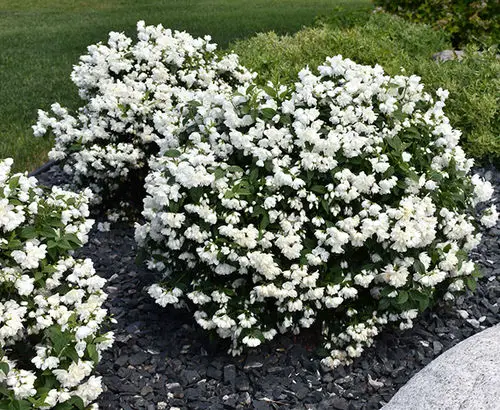
Botanical Name: Philadelphus
This fragrant shrub blooms in late spring to early summer with pure white to cream flowers. For the best blossoms, make sure it gets plenty of sunlight.
10. Rose

Botanical Name: Rosa
Prune your roses in early spring to enhance the growth of baby buds, which then bloom into exotic shades of red, pink, white, and yellow in summer.
Learn the best hack for growing Roses here
11. Ixora

Botanical Name: Ixora coccinea
Ixoras are evergreen shrubs covered with clusters of four-petalled blooms that garnish home gardens. The flowers come in pink, red, yellow, orange, and white shades.
12. Smoke Bush
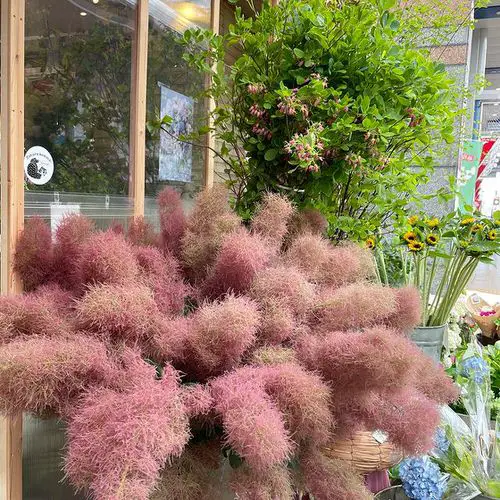
Botanical Name: Cotinus
This large shrub has dark red-purple leaves and blooms candy floss clusters of fluffy flowers like smoke during summer.
Get some top-notch Summer gardening tips here
Fall
13. Bluebeard
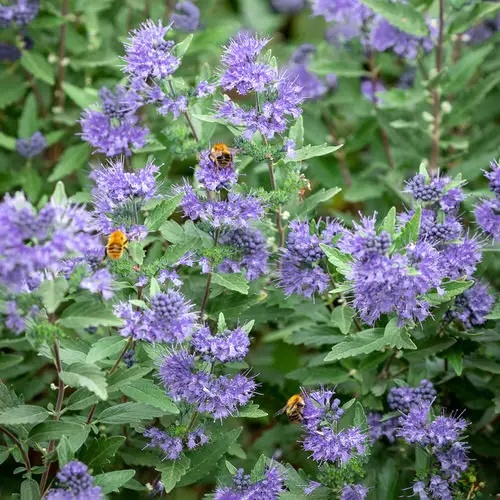
Botanical Name: Caryopteris
These plants start flowering in late Summer with blue to purple flowers until fall. They are better in a sunny location and well-drained soil.
14. Glossy Abelia

Botanical Name: Abelia x grandiflora
This shrub is excellent as a background plant because of its ever-changing variegated foliage. Its colors include gold and orange with evergreen leaves in flame shades.
15. Harlequin Glorybower

Botanical Name: Clerodendrum trichotomum
Its white and purple-pink flower clusters are nestled above its heart-shaped leaves, either cream, sage green, or deep green.
16. Hydrangea

Botanical Name: Hydrangea
Prune the shrub in late fall or early spring to enjoy beautiful flowers in the fall. In fact, hydrangeas bloom in summer as well, depending on the type.
Learn about growing Hydrangea from cuttings here
17. Spindle

Botanical Name: Euonymus europaeus
The fall flowers of this bushy shrub are fruits that split to uncover seeds in contrasting hues. Euonymus europaeus ‘Red Cascade’ is the best one to grow.
Want to make a Fall balcony garden? Click here
Winter
18. Daphne Odora
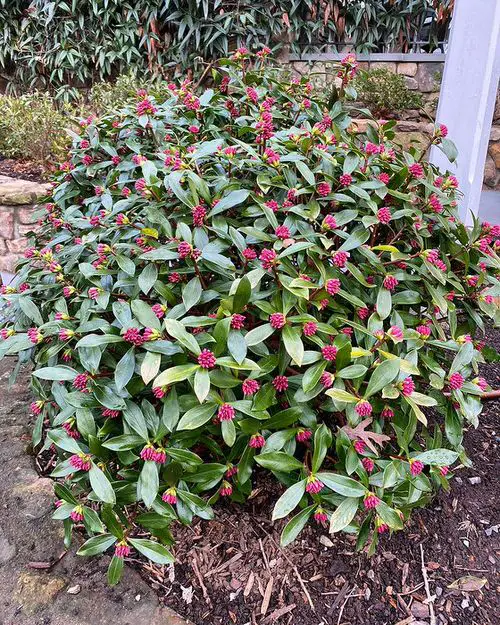
Botanical Name: Aureomarginata
With its beautiful clusters of fragrant pink flowers, this evergreen shrub looks great. It blooms anytime from mid-winter to early spring.
19. Rubella

Botanical Name: Skimmia japonica
Its panicles of red buds appear in winter, making it among the most colorful shrubs in your garden. The cones of flowers stay through winter and open in early spring.
20. Mahonia

Botanical Name: Mahonia
Mahonias show off holly-like foliage and deep purple berries. The spikes of fragrant yellow blooms appear in late fall, winter, and spring.
Check out some exciting Winter gardening projects here



I have 3 buddia ((butterfly bushes).I understand they are suppose to grow wide and high. Mine have not, one does better than the other two. I am so disappointed in them, was told to cut them back in early spring down to 12 to 18 inches. Not goin to this spring. I need help w/ them. Do I need to use more fertilizer, if so , what kind?
I have one, quite old now, wide high and lots of new growth all the time. New seedlings coming up everywhere. I don’t fertilise but gets watered with sprinkler with rest of garden. In Adelaide Hills.
You do get small buddia that only grow two or three feet in hight.
I’ve read repeatedly to never fertilize buddleja, so that’s not the answer. I understand your frustration because I’ve repeatedly planted, and lost, buddleja bushes for the past few years. They’ll look good the first year, but they either don’t come back at all the following year, or they barely come back and don’t grow much at all during the season, then end up not coming back the following year. I’m in zone 8, and they are all in full sun and well drained soil. I’m so frustrated at the tales of huge, 9 foot buddlejas when mine never get more than a foot high & wide. And no, they are not the smaller hybrids. These are black knight, supposedly the biggest cultivar. I’ve also tried the smaller hybrids, and 2 out of 3 of them never returned the following season, and the remaining one is also stunted and poor looking.
I have a couple of Budlia,hope I have spelt it right have had them a few years they grow tall I don’t feed them and I have clay soil and they seem to do well
I bought a few of those miniature butterfly bushes 2 years ago and thought I could use them to line the walkway from the garden gate towards the large BB black knight, I was not impressed with thier diminutive blooms especially when you look at the regular BB display. I don’t fertilize mine at all after I did about 5 years ago with all purpose fertilizer and they grew so much and had fewer blooms. I just wait till they leaf out completey after winter, then cut all old wood. They are a beautiful site as you know. I added very low flowing mini solar fountain and those monarchs just party like it’s 1999. I think they are one of the easier to manage and very rewarding shrubs.
I think this page rocks I am gonna tell everyone I see
I have a butterfly bush I cut mine back when it stops blooming I use it easter time to hang eggs on came back wide and bushy use pine tags to cover in winter cold may burn
Plants that bloom throughout the year which of them would be good for honey bees?
Borage. It’ll feed those honey bees throughout winter. I let it volunteer over and over again and thus I have Borage blooming throughout most of the year.
In what part of the country will these grow? Pennsylvania has harsh winters.
Where can these bushes be bought?
Nancy Ashburn, if you live in Zones 5 – 9, you can find these at most every nursery or garden center.
Butterfly bushes thrive in a drier climate and partial shade. I’m in the rockies, mine are 9ft. My brother is in FL, he hasn’t had much success at all. I dont mulch the bottom when getting ready for winter, but mine are against my home and most likely draw heat that way. The first year they should reach 4ft. The next year they double in size.
So much wonder information is available for gardening in the north and east. But, I’m in Central/South Texas. The land here is very alkaline, rocky, and full of a white clay called kalechi. Add that to the hot summer tempo and it’s pretty hard to keep a nice yard of grass, much less flowers.
Many plants survive with a lot of lover but blooms are often few if at all.
Sure would be nice if someone would share information on growing real flowering plants and bushes here.
I’m close to you and my butterfly bush thrives. It likes full sun and water regularly.
Sounds like the Lexington/Rockdale/Thorndale area, where I used to live. I’m in East Texas now, and loving it here too!
Hi Joan, I’m Sandy on the Southcoast of Oregon. Some dear friends moved here from Texas, they told me they always bought big pots and containers , and had them on their walkways etc. she said it was the only she could have beautiful flowers. I saw the pics, it was really beautiful!
Roses are very hardy in central Texas. Try the knock outs. You should be able to grow lavender easily there as well. Don’t water but once every two or three weeks though. Lantana blooms all summer and fall; very self sustaining.
Lantana make the most gorgeous shrubs
Another easy blooming shrub for central/ south Texas is esperanza. All of tbese ive listed attract butterflies bees and hummingbirds.
How tall do lantana plants get?
I love Lantana and in my experience the size varies based on where they are planted. In full sunlight we had one plant which covered a 4×4 area after a few years. I planted several this year which ended up being shaded by a fig tree that grew over them. Although they grew to cover about a 2×2 area, they did not grow as many leaves and did not flower as much as they did before the fig tree grew over them. I planted several in some very hard soil and although they were in a mostly sunny area, they did not grow as much as the others planted at the same time. We had a 4″ snow last night and I hope I protected them enough by covering them with pine straw that they will come back next year. Good luck!
pretty colors this years
Many are only about 8-10″ tall, but as a kid we had some that got up to probably 15-18″ in the center. Seems like they have a tendency to mound. They do very well in direct sun and with little water.
This is great information. I live in North Florida and we have very hot summers. By mid September or early October most of our flowering plants are burned. Thank you for this post and if you have more info on flowering evergreens, I would love to hear it.
BUTTERFLY BUSHES ARE INVASIVE INT HE NW AND ARE NOT SOLD
I live in West Virginia. I would like some flowering perrenial shrubs. I have 2 Lilacs but one blooms for a short time and the other one has not started blooming. Roses do not do well.
I live in the Vancouver, BC area in Canada. I planted a butterfly bush about 7 years ago. It was supposed to be a miniature bush but was obviously mistagged as it grows to about 16 feet in the early summer and is loaded with an unbelievable amount of flowers about 5 -6 inches long. I cut it back in spring usually beginning of March to about 8 feet tall and then it has loads of new growth and so many flowers that the branches lean over with the weight. It is up against a south facing fence (to support the weight). It blooms for maybe 2 months if you cut back the flowers that are finished blooming. I then leave the last blooms on the tree (supposed to be a bush) and the winter birds love to eat the seeds all winter. Hummingbirds and butterflies all over the tree when in bloom. Out of guilt I water my tree maybe 2 times a year and have never fertilized it. It has sun for about 6 – 8 hours a day and it has been up in the 30’s this year. The bottom of the tree is in shade and don’t know if that has anything to do with the growth. Most ignored tree in my yard and best producer. I have people I do not know stop and ask me what it is.